Protect Your Home: The Essential Guide to Crawlspace Encapsulation in Indian River, Michigan
Posted on October 17, 2025

If you're a homeowner in Indian River, Michigan, you understand the importance of safeguarding your home against the elements, especially when the weather turns challenging. One crucial yet often overlooked area is your crawlspace. Crawlspace encapsulation is more than just a buzzword; it's an essential step in ensuring your home operates efficiently and maintains its structural integrity.
Why Crawlspace Encapsulation Matters
In Indian River's humid climate, moisture can easily seep into crawlspaces, leading to mold growth, structural damage, and increased energy costs. Encapsulation involves covering the crawlspace floor and walls with a durable vapor barrier that prevents moisture infiltration. This process not only mitigates the risk of mold but also enhances indoor air quality and helps maintain a comfortable home environment.
By opting for crawlspace encapsulation, Indian River residents can protect their home investments and enjoy peace of mind knowing their family's health and energy bills are safeguarded. Furthermore, encapsulated crawlspaces contribute to a cleaner and more energy-efficient home by preventing drafts and energy loss.
At our property damage restoration company, our professional services in Indian River are tailored to meet the specific needs of Indian River homes. Our teams are always ready to help residents of the greater Indian River area, ensuring a customized approach to crawlspace encapsulation that addresses unique structural concerns and optimizes performance.
Don't let your crawlspace be an afterthought. Consult with experts who understand the local climate and offer comprehensive solutions that protect and enhance your home's value. Explore the benefits of crawlspace encapsulation today and secure a healthier, more energy-efficient home for future generations in Indian River.
